The OnePlus One Review
by Joshua Ho on November 19, 2014 8:00 AM EST- Posted in
- Smartphones
- Android
- Mobile
- OnePlus
Battery Life
At this point, battery life is one of the number one priorities for a phone. While in 2013 our primary tests consisted of the web browsing test and video playback tests, we've expanded our suite to include Basemark OS II and GFXBench to simulate intensive general usage and gaming, respectively. For all of our tests in which the display is on, we calibrate the brightness of full white to be 200 nits in order to standardize and attempt to control for extraneous variables as much as possible. While this may seem arbitrary, it's important to do so to draw real conclusions about which phone has better battery life. 200 nits on a phone can be as low as 50% and as high as 90%, so setting a standardized brightness percentage would not be an effective method of controlling for display brightness. With that in mind, let's get to the battery life tests.

Here, we see that the OnePlus One takes the number three spot for battery life amongst phones and phablets. This is definitely a great result to start with, and is a solid 20% higher than the One (M8). However, the Huawei Ascend Mate 2 continues to hold its position with a long lead over just about anything else available in the market today.
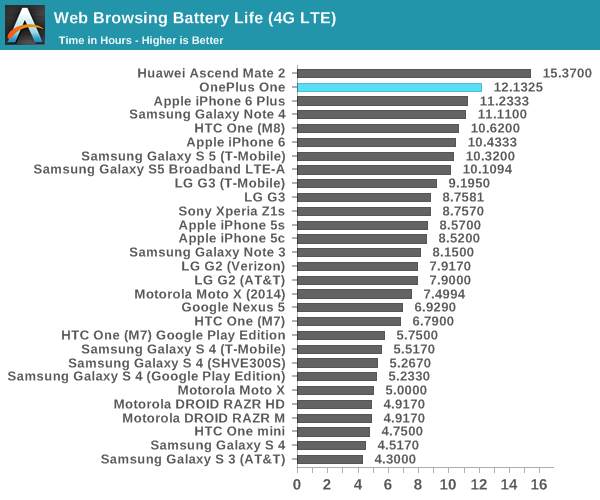
We can see a similar story in LTE web browsing battery life. However, the OnePlus One manages to close up the lead that the Ascend Mate 2 holds in WiFi browsing. It's likely that the 28nm LP process and lack of envelope tracker is responsible for closing the gap in this regard. It's interesting to see how the iPhone 6 Plus trails behind the OnePlus One here, but it's likely that this difference is due to the fact that the iPhone 6 Plus has an off-die modem compared to the OnePlus One's on-die modem.
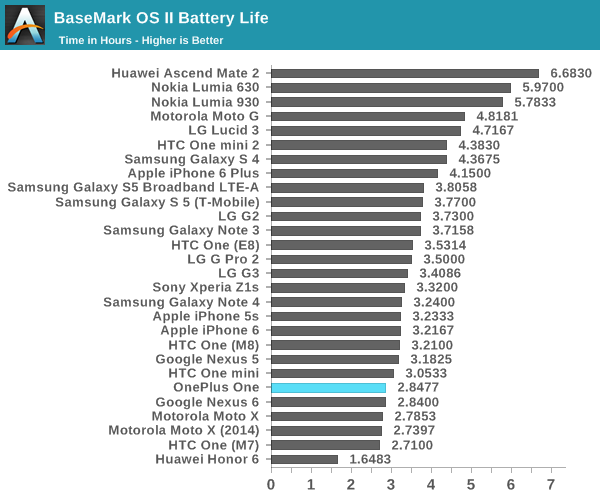

White battery life tends to fall towards the bottom here, we can see that the reality is that the OnePlus One performs quite well, which indicates that there's relatively little throttling to speak of and that the OnePlus One is simply doing well by sustaining high levels of performance.
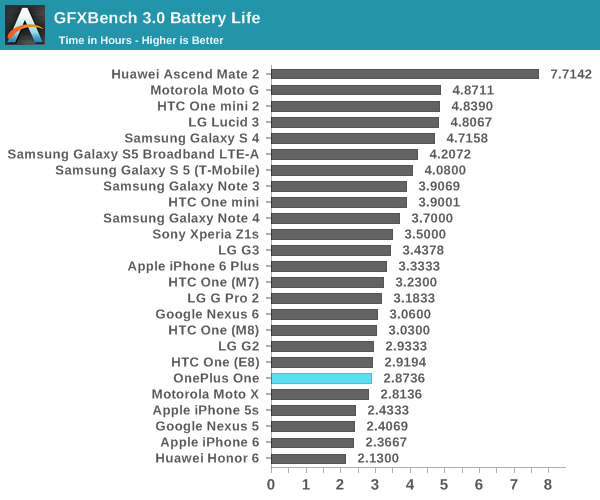
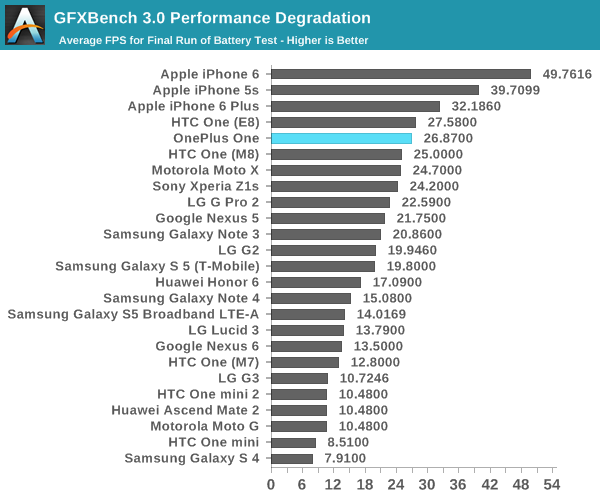
We see the same story in the GFXBench rundown. The OnePlus One manages to set a new record for final run FPS among phones and phablets, although battery life is near the bottom of the pack. It seems that if there's any one reason for the escalating display size wars, it is to increase battery life. While by no means a clear order, we can see that the larger battery more than compensates for the larger display of the OnePlus One. This makes sense, as a phone should have a fixed size circuit board. Therefore, by increasing display size the circuit boards become smaller relative to the rest of the phone, and all of the area opened up by increasing the size of the phone can be taken up by the battery. Overall, the OnePlus One is almost as good as it gets for battery life in a phone, with excellent sustained performance under load.
Charge Time
To really have a holistic understanding of battery life, we must also take a look at charge time. While battery life can be the only determinant of mobility, in cases where usage is heavy enough that the battery or multiple batteries have to be charged, charge time can become incredibly important. To this end, OnePlus includes a 5V, 2.1A charger in the box to quickly charge the rather large 11.78 WHr battery.
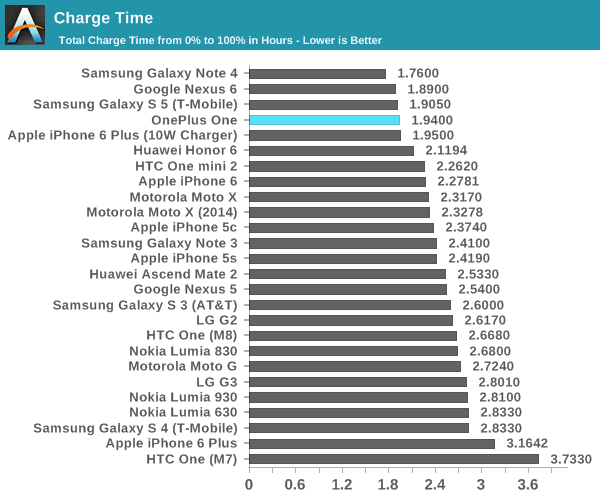
Somewhat surprisingly, the OnePlus One does a great job in this test, coming quite close to other devices with QC 2.0 fast chargers like the Galaxy Note 4 which is definitely good to see. Overall, this makes the OnePlus One one of the best phablets on the market for battery life.










148 Comments
View All Comments
flyingpants1 - Wednesday, November 19, 2014 - link
It doesn't matter, since the screen takes most of the battery power. You have a point about the bezels, though.tipoo - Wednesday, November 19, 2014 - link
Yes, but the added area for the battery has consistently been shown to outweigh that con, ie larger phones are nearly always at the top of the battery life charts outside of outliers like super low power SoCs or huge thick batteries.srkelley - Thursday, November 20, 2014 - link
Honestly, the bezel sort of disappears while you're using this phone. I can definitely see how it would bother some people now, but in the end it can negligible if this is your sort of phone.Also, great review Joshua. I could not have done anything better myself here.
piroroadkill - Friday, November 21, 2014 - link
"but it couldn't have accommodated such a large battery with a smaller one."So there's no way I have a 4.7" phone with a 3300mAh battery then.. oh wait, I do..
DIYEyal - Monday, November 24, 2014 - link
I have a 5" phone with a 5000mAh battery.nevertell - Wednesday, November 19, 2014 - link
"While one can guess that an airplane is for airplane mode and a flashlight is for the torch, a circular arrow is utterly ambiguous in nature. Given the quick access nature of this menu, one might guess that this is a rotation lock toggle but for one reason or another it's actually the auto-sync toggle."Yes, but this is the same icon Google has used in their quick-settings-toggle widgets, with the only difference being that in this case, the quick settings ribbon is accessible in the drop down notifications shade instead on a homsecreen. Whilst it may be hard to understand the meaning of this icon, it is not like the same icon isn't used on most other devices to represent google's autosync.
JoshHo - Wednesday, November 19, 2014 - link
The issue is that this icon is given without any text to explain what it really is. It can be obvious to some but confusing to a lot of people.metayoshi - Wednesday, November 19, 2014 - link
I don't think the Auto Sync circle-arrow has actually been in the quick settings in any official Google ROM, correct me if I'm wrong, so I feel like CM and the rest of the AOSP community may have came up with it themselves. From what I remember, you have, User, Brightness, settings, WiFi, Bluetooth, Battery, Airplane Mode, Auto Rotate, and recently, Cast Screen. Android 5.0 finally added a flashlight officially. No Auto Sync mode.metayoshi - Wednesday, November 19, 2014 - link
Correction to my post: Auto Rotate was only on Tablets. The Auto Rotate quick setting was replaced by Mobile Data on Phones.tipoo - Wednesday, November 19, 2014 - link
Why does the Oneplus One set a record for final run score in the degradation test, when the 6, 6 plus, and HTC One are above it? Or is that including how long it runs relative to those?